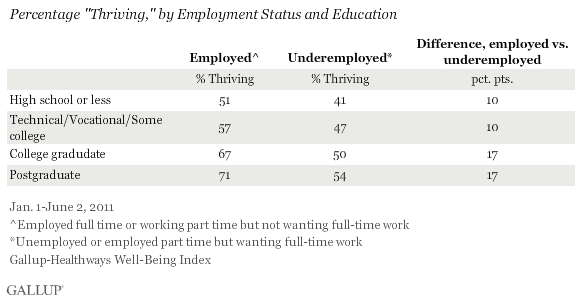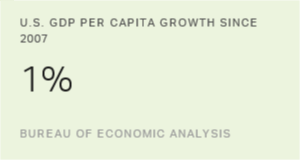WASHINGTON, D.C. -- Underemployment is tougher on the life evaluation ratings of college graduates and postgraduates than on Americans who are less educated. The percentage of highly educated underemployed Americans who rate their lives well enough to be considered "thriving" is 17 percentage points lower than their employed counterparts. Among the less educated, thriving drops 10 points when underemployed.

Although underemployment appears to have a greater effect on how the highly educated rate their lives, they are still more positive than the less educated who are also underemployed.
Gallup-Healthways Well-Being Index data from Jan. 1 to June 2, 2011, find that on average 60% of all employed Americans are thriving, but that this rises to 67% among college graduates and 71% among postgraduates.
Gallup categorizes Americans as thriving, struggling, or suffering depending on how they rate their present life and life five years from now using a ladder scale, which is based on the Cantril Self-Anchoring Striving Scale, with steps numbered from 0 to 10, where "0" represents the worst possible life and "10" the best. Those who are thriving rate their present life a 7 or higher and their life in five years an 8 or higher.
Mid- to Late-Career Aged Also See a Large Decline in Life Evaluation With Underemployment
The effects of underemployment on a person's life evaluation also vary by age. Americans who are more likely to be in their mid- to late career -- those between the ages of 30 and 64 -- are the most likely across age groups to downgrade their life outlook if underemployed. The percentage of underemployed 30- to 44-year-olds who are thriving is 23 points lower than those who are the same age but employed. Underemployed 45- to 64-year-olds are 21 points less likely to be thriving than their employed counterparts. In contrast, the percentage of young adults who are thriving declines 10 points when underemployed.
Underemployment negatively affects life ratings of white Americans more than blacks, Hispanics, or Asians. High-income Americans are also slightly more likely to lower their life ratings when underemployed than are those with lower incomes. However, employed Americans in lower income households are still less likely to be thriving than underemployed Americans in middle- and upper-income houses.

Implications
The differences across all demographic groups analyzed hold when controlling for income and age. Taken together, the findings suggest that there is something about having achieved a higher level of education and about being mid- to late-career age that allows underemployment to have a more significant effect on on one's life.
There are several possible reasons for this: Americans who have a higher education have likely invested significantly more money in their schooling than have those without a college degree and may also have student loan debt. College and postgraduate degrees also require a large investment of time. When underemployed, highly educated Americans may have a more negative reaction concerning their commitment of resources -- time and money.
Similarly, mid- to late-career-aged Americans may be more likely to view the loss of a job or not having enough work as a severe loss of the time and efforts they had previously put into their career. And middle-aged Americans may also have expected to reach a certain stage of comfort and security by this point in their lives.
The relationship between underemployment and education may also be tied to expectations. Less well-educated people may be more used to unemployment or underemployment, whereas those with a college education are more likely to expect that their degree should protect them against joblessness. Gallup's measure of unemployment underscores this point as it finds those with a high school education or less are the most likely to be unemployed, while postgraduates are the least likely.
About the Gallup-Healthways Well-Being Index
The Gallup-Healthways Well-Being Index tracks U.S. and U.K. well-being and provides best-in-class solutions for a healthier world. To learn more, please visit well-beingindex.com.
Survey Methods
Results are based on telephone interviews conducted as part of the Gallup-Healthways Well-Being Index survey Jan. 1-June 2, 2011, with a random sample of 95,667 adults who are part of the workforce, aged 18 and older, living in all 50 U.S. states and the District of Columbia, selected using random-digit-dial sampling.
For results based on the total sample of national adults, one can say with 95% confidence that the maximum margin of sampling error is ±1 percentage point.
For results based on the sample of 18,217 underemployed adults, one can say with 95% confidence that the maximum margin of sampling error is ±1.5 percentage points. For results based on the sample of 77,450 fully employed adults, one can say with 95% confidence that the maximum margin of sampling error is less than ±1 percentage point.
Interviews are conducted with respondents on landline telephones and cellular phones, with interviews conducted in Spanish for respondents who are primarily Spanish-speaking. Each sample includes a minimum quota of 400 cell phone respondents and 600 landline respondents per 1,000 national adults, with additional minimum quotas among landline respondents for gender within region. Landline telephone numbers are chosen at random among listed telephone numbers. Cell phone numbers are selected using random-digit-dial methods. Landline respondents are chosen at random within each household on the basis of which member had the most recent birthday.
Samples are weighted by gender, age, race, Hispanic ethnicity, education, region, adults in the household, and phone status (cell phone only/landline only/both, cell phone mostly, and having an unlisted landline number). Demographic weighting targets are based on the March 2010 Current Population Survey figures for the aged 18 and older non-institutionalized population living in U.S. telephone households. All reported margins of sampling error include the computed design effects for weighting and sample design.
In addition to sampling error, question wording and practical difficulties in conducting surveys can introduce error or bias into the findings of public opinion polls.
For more details on Gallup's polling methodology, visit www.gallup.com.
